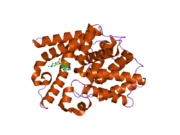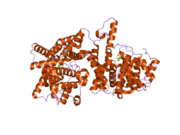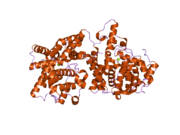Biology:PDE10A
 Generic protein structure example |
cAMP and cAMP-inhibited cGMP 3',5'-cyclic phosphodiesterase 10A is an enzyme that in humans is encoded by the PDE10A gene.[1][2]
Various cellular responses are regulated by the second messengers cAMP and cGMP. Phosphodiesterases, such as PDE10A, eliminate cAMP- and cGMP-mediated intracellular signaling by hydrolyzing the cyclic nucleotide to the corresponding nucleoside 5-prime monophosphate.[2][3]
Inhibitors

- Compound 96: IC50 = 700 pM, high selectivity against all other members of the PDE family[4]
- Papaverine[5]
- PF-2545920[6]
- TAK-063: IC50 = 300 pM[7]
- AMG 579[8]
- CPL500036[9]
Research
Preliminary evidence indicates a possible link between PDE10A expression and obesity in mice and humans.[10] PDE10A is a regulatory protein involved in the signaling of the striatum, a region of the brain important for controlling movement and cognition. Dysfunction of the striatum has been linked to the development of schizophrenia. Inhibition of PDE10A has been identified as a potential treatment for the disorder, and an inhibitor compound (MK-8189) is as of February 2023 in Phase 2b clinical development for the treatment of schizophrenia.[11]
References
- ↑ "Cloning and characterization of a novel human phosphodiesterase that hydrolyzes both cAMP and cGMP (PDE10A)". The Journal of Biological Chemistry 274 (26): 18438–18445. June 1999. doi:10.1074/jbc.274.26.18438. PMID 10373451.
- ↑ 2.0 2.1 "Entrez Gene: PDE10A phosphodiesterase 10A". https://www.ncbi.nlm.nih.gov/sites/entrez?Db=gene&Cmd=ShowDetailView&TermToSearch=10846.
- ↑ "The human phosphodiesterase PDE10A gene genomic organization and evolutionary relatedness with other PDEs containing GAF domains". European Journal of Biochemistry 267 (19): 5943–5951. October 2000. doi:10.1046/j.1432-1327.2000.01661.x. PMID 10998054.
- ↑ 4.0 4.1 "Highly potent, selective, and orally active phosphodiesterase 10A inhibitors". Journal of Medicinal Chemistry 54 (21): 7621–7638. November 2011. doi:10.1021/jm2009138. PMID 21988093.
- ↑ "Inhibition of the striatum-enriched phosphodiesterase PDE10A: a novel approach to the treatment of psychosis". Neuropharmacology 51 (2): 386–396. August 2006. doi:10.1016/j.neuropharm.2006.04.013. PMID 16780899.
- ↑ "Discovery of a novel class of phosphodiesterase 10A inhibitors and identification of clinical candidate 2-[4-(1-methyl-4-pyridin-4-yl-1H-pyrazol-3-yl)-phenoxymethyl]-quinoline (PF-2545920) for the treatment of schizophrenia". Journal of Medicinal Chemistry 52 (16): 5188–5196. August 2009. doi:10.1021/jm900521k. PMID 19630403.
- ↑ "Discovery of 1-[2-fluoro-4-(1H-pyrazol-1-yl)phenyl]-5-methoxy-3-(1-phenyl-1H-pyrazol-5-yl)pyridazin-4(1H)-one (TAK-063), a highly potent, selective, and orally active phosphodiesterase 10A (PDE10A) inhibitor". Journal of Medicinal Chemistry 57 (22): 9627–9643. November 2014. doi:10.1021/jm5013648. PMID 25384088.
- ↑ "Discovery of clinical candidate 1-(4-(3-(4-(1H-benzo[d]imidazole-2-carbonyl)phenoxy)pyrazin-2-yl)piperidin-1-yl)ethanone (AMG 579), a potent, selective, and efficacious inhibitor of phosphodiesterase 10A (PDE10A)". Journal of Medicinal Chemistry 57 (15): 6632–6641. August 2014. doi:10.1021/jm500713j. PMID 25062128.
- ↑ "A PDE10A inhibitor CPL500036 is a novel agent modulating striatal function devoid of most neuroleptic side-effects". Frontiers in Pharmacology 13: 999685. 2022. doi:10.3389/fphar.2022.999685. PMID 36438799.
- ↑ "A novel thermoregulatory role for PDE10A in mouse and human adipocytes". EMBO Molecular Medicine 8 (7): 796–812. July 2016. doi:10.15252/emmm.201506085. PMID 27247380.
- ↑ "Discovery of MK-8189, a Highly Potent and Selective PDE10A Inhibitor for the Treatment of Schizophrenia". Journal of Medicinal Chemistry 66 (2): 1157–1171. January 2023. doi:10.1021/acs.jmedchem.2c01521. PMID 36624931.
Further reading
- "Isolation and characterization of PDE10A, a novel human 3', 5'-cyclic nucleotide phosphodiesterase". Gene 234 (1): 109–117. June 1999. doi:10.1016/S0378-1119(99)00171-7. PMID 10393245.
- "Characterization and phosphorylation of PDE10A2, a novel alternative splice variant of human phosphodiesterase that hydrolyzes cAMP and cGMP". Biochemical and Biophysical Research Communications 261 (3): 551–557. August 1999. doi:10.1006/bbrc.1999.1013. PMID 10441464.
- "HIV-1 Tat protein down-regulates CREB transcription factor expression in PC12 neuronal cells through a phosphatidylinositol 3-kinase/AKT/cyclic nucleoside phosphodiesterase pathway". FASEB Journal 15 (2): 483–491. February 2001. doi:10.1096/fj.00-0354com. PMID 11156964.
- "The gamma subunit of the rod photoreceptor cGMP phosphodiesterase can modulate the proteolysis of two cGMP binding cGMP-specific phosphodiesterases (PDE6 and PDE5) by caspase-3". Cellular Signalling 13 (10): 735–741. October 2001. doi:10.1016/S0898-6568(01)00193-0. PMID 11602184.
- "cAMP is a ligand for the tandem GAF domain of human phosphodiesterase 10 and cGMP for the tandem GAF domain of phosphodiesterase 11". The Journal of Biological Chemistry 281 (5): 2841–2846. February 2006. doi:10.1074/jbc.M511468200. PMID 16330539.
- "Current landscape of phosphodiesterase 10A (PDE10A) inhibition". Journal of Medicinal Chemistry 55 (17): 7299–7331. September 2012. doi:10.1021/jm3004976. PMID 22834877.
This article incorporates text from the United States National Library of Medicine, which is in the public domain.
 |












